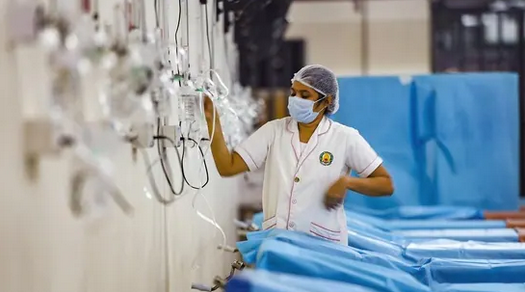Cost of Non-COVID Healthcare Saw Huge Rise During Pandemic, Says Study

Image Courtesy: PTI
Heavy restrictions imposed by the Union government during the pandemic caused a fall in healthcare utilisation. However, during the same period, occurrence of catastrophic health expenditure increased for hospital utilisation, according to a study published earlier this month in the BMC journal.
For the study, panel data from two rounds of annual household surveys conducted in Chhattisgarh for the years 2019 and 2020 were analysed. The survey followed a two-stage population based sample of around 3,000 households, which were representative of the state’s population. Two kinds of measures for catastrophic health expenditure (CHE) were used – annual household consumption expenditure and non-food consumption expenditure.
The study found that the access to hospital care for non-Covid needs suffered significantly during the pandemic. “The fall in healthcare utilisation during the pandemic suggests that the government response of imposing heavy restrictions may be harmful during such situations. The Covid-19 pandemic also exposed the country’s fragile health system,” the study said.
The study added that occurrence of catastrophic expenditure increased for hospital utilisation during the pandemic, while publicly funded insurance schemes like Pradhan Mantri Jan Arogya Yojana (PMJAY), though designed to cover hospitalisation costs, remained ineffective in controlling Out of Pocket Expenditure (OOPE) in private hospitals during the pandemic. “Utilisation in the private sector was a key determinant of catastrophic health expenditure,” it said.
During the pandemic, the government diverted many of its hospitals for treating Covid-19 patients. In addition, some new or make-shift public facilities were built to focus exclusively on Covid-19 patients. The government policies on maintaining essential healthcare services during the pandemic mandated the continuation of primary care services like immunisation and ante-natal care. Hospitals were expected to continue admissions for child birth and neonatal care. The elective surgeries, however, were discontinued. It included services for cataract, family planning and orthopaedic care. However, there were no restrictions on private hospitals regarding non-Covid hospitalisations.
In 2019, 58.2 hospitalisations had taken place per 1,000 population and it declined to 36.6 per 1,000 in 2020. As compared to 2019, the utilisation of inpatient care declined by 37% in 2020. The decline was less pronounced in case of maternal care as compared to the average. The decline was sharper in case of injuries and communicable diseases. 67% of those seeking hospital care utilised public hospitals in 2020 and the rest used private hospitals. In 2019, the share of public hospitals in hospitalisations was 60.1%.
The mean OOPE per hospitalisation increased from Rs 16,165 in 2019 to Rs 19,322 in 2020. For public hospitals, the mean OOPE per hospitalisation increased from Rs 4,141 in 2019, to Rs 4,324 in 2020. However, the increase in OOPE per hospitalisation for private hospitals was much higher, it increased from Rs 34,989 in 2019, to Rs 47,572 in 2020. Enrolment under Publicly Funded Health Insurance (PFHI) schemes, including the flagship Ayushman Bharat scheme, was not effective in reducing OOPE or catastrophic expenditure, found the researchers.
The study pointed out that while a small increase in OOPE was expected due to the additional cost incurred by private hospitals on personal protective equipment during the pandemic, the mean OOPE in private hospitals increased sharply, by 30% from 2019 to 2020. “The increase in OOPE for private hospitals cannot be explained by the cost of personal protective equipment. Though the demand reduced, the private hospitals did not reduce their charges,” it said.
It also highlighted that there was no new policy response from the government to protect the poor from CHE. The study found that enrolment under PMJAY or other health insurance schemes was not effective in reducing chances of incurring CHE. The enrolment under PFHI schemes increased, but it could not fulfil its promise of free care, according to the researchers. “The failure of PMJAY in controlling OOPE in private sector could be related to long-standing problem of double-billing under publicly funded health insurance in India. Contracting was ineffective in ensuring adherence of private hospitals to agreed prices,” the study said.
In conclusion, the authors said, “There is a need to find ways to regulate the private hospitals in India and to limit overcharging. Implementation of strategies to increase the share of public sector in healthcare utilisation can help in reducing OOPE. The overall health system of the country needs to be strengthened to address the challenges posed by such emergencies and a consensus strategy needs to be evolved by involving both public and private sectors.”
Get the latest reports & analysis with people's perspective on Protests, movements & deep analytical videos, discussions of the current affairs in your Telegram app. Subscribe to NewsClick's Telegram channel & get Real-Time updates on stories, as they get published on our website.
























